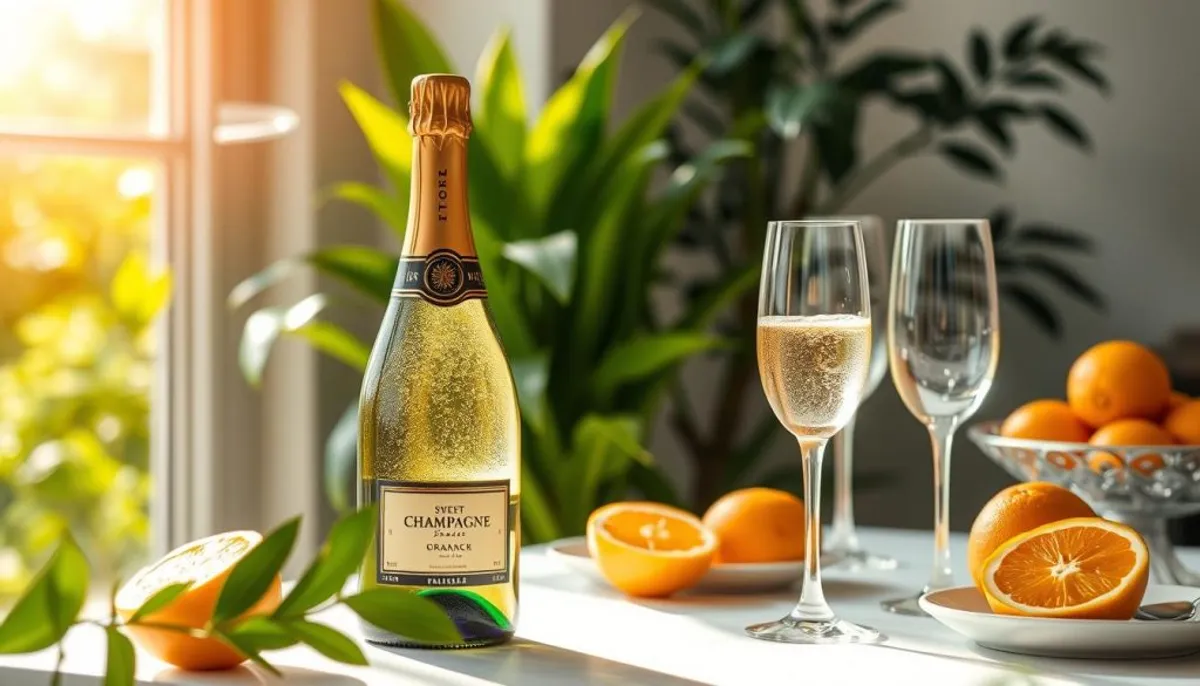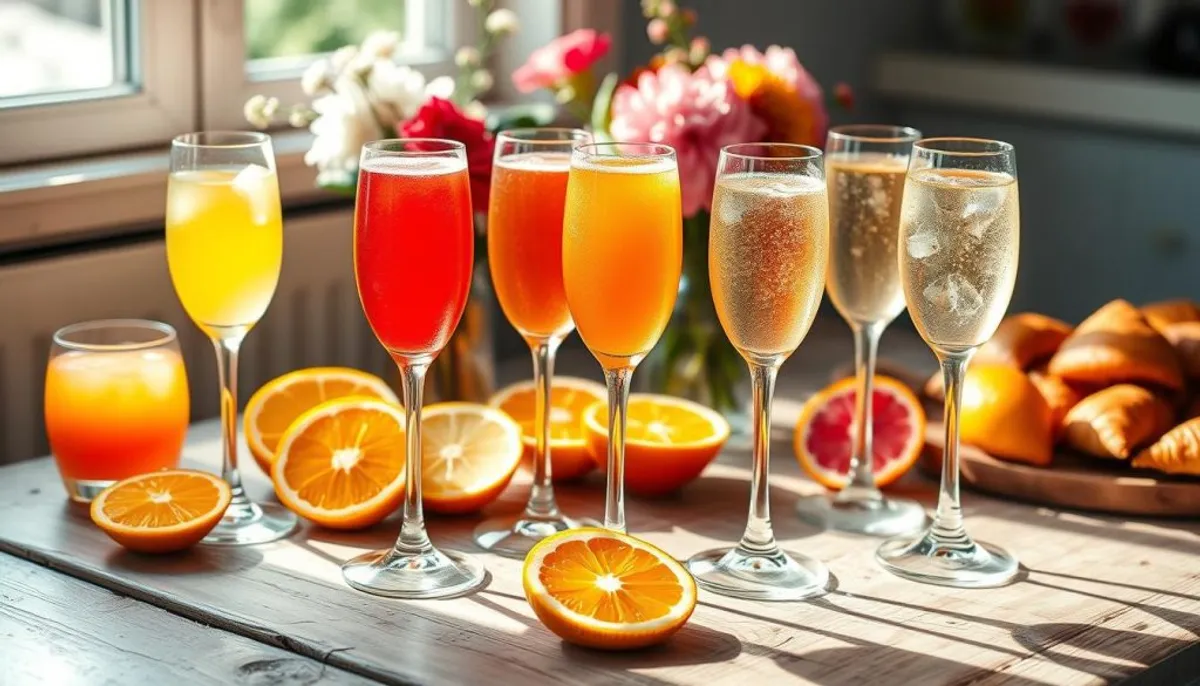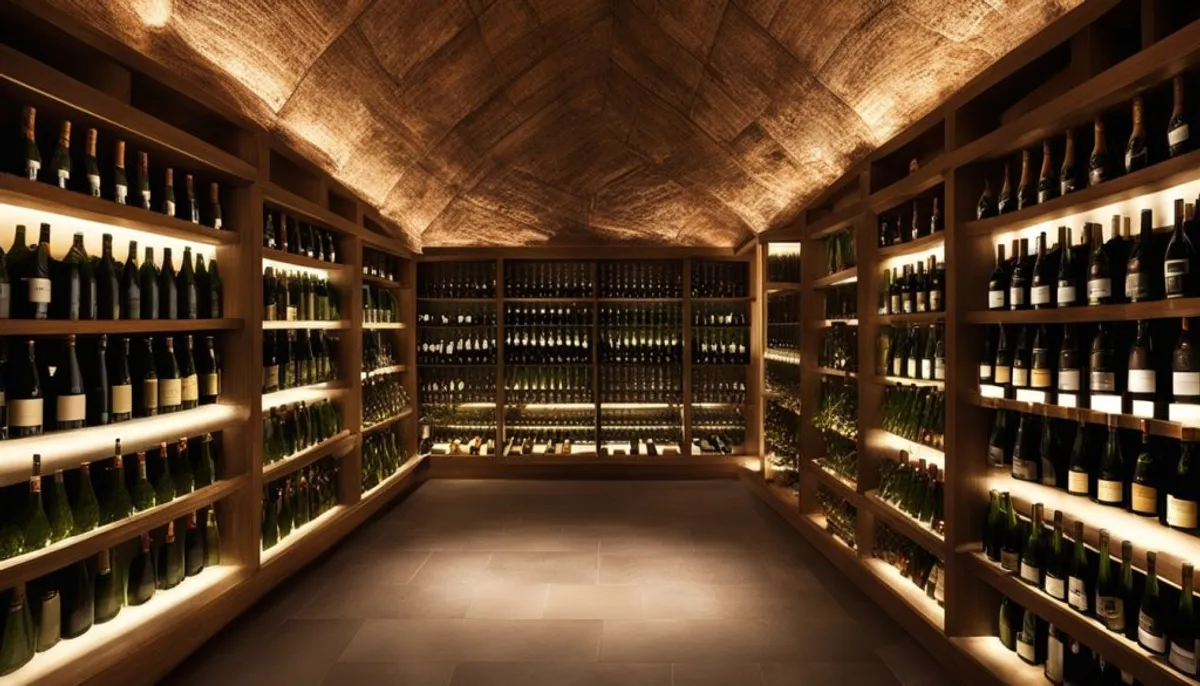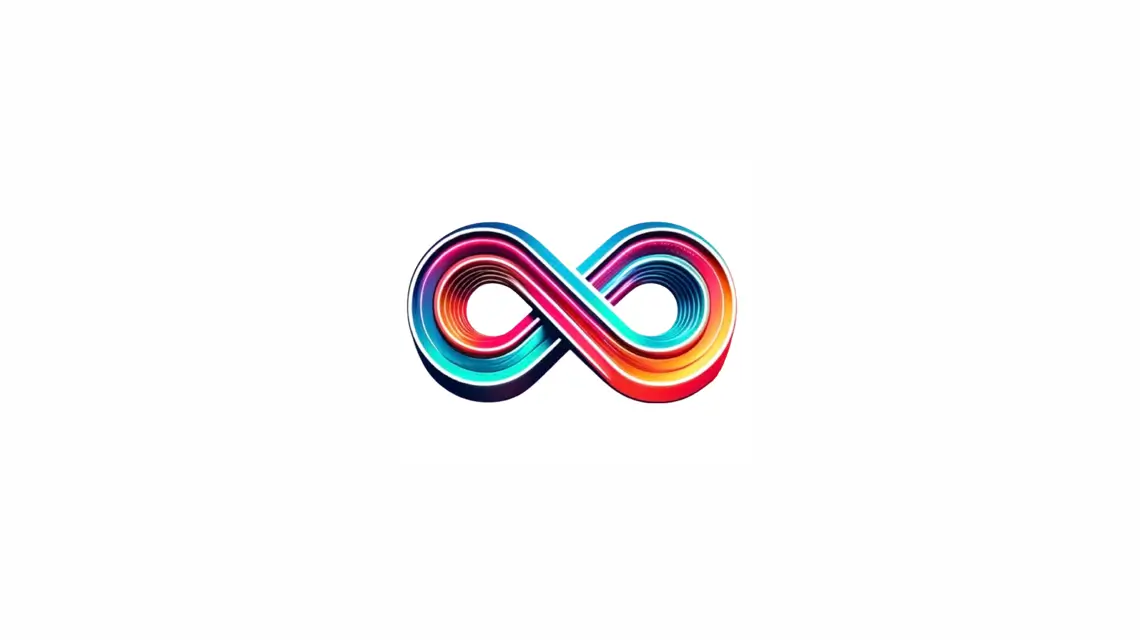Brunch has become even more delightful with the introduction of sweet champagne. Searching for the ideal champagne to enhance your mimosas? You’re in for a delightful journey. We’ve extensively tasted numerous bottles to present the finest sparkling wines for your brunch cocktail needs.
Our selection spans from classic French Champagnes to Italian Proseccos and Spanish Cavas. Each option caters to diverse tastes and budgets. Whether you’re hosting an opulent brunch or a laid-back gathering, our guide will assist in finding the perfect champagne to pair with your orange juice.

Are you ready to explore the realm of sweet champagne and brunch cocktails? Let’s uncork the adventure and discover the top sparkling wines for mimosas that will delight your senses!
Key Takeaways
- Sweet champagne enhances the flavor profile of mimosas
- Prosecco and Cava are budget-friendly alternatives to Champagne
- Veuve Clicquot Brut Yellow Label is a premium choice at $21 (67% off) from Drizly
- Korbel Brut California Champagne offers great value at $9 from Total Wine
- Non-alcoholic options like St Regis Nosecco are available for mocktails
- Proper mixing ratios and serving techniques enhance the mimosa experience
- Sparkling rosé adds a colorful twist to traditional mimosas
Understanding Different Types of Sparkling Wines for Mimosas
Exploring the realm of sparkling wines for mimosas unveils a plethora of choices. From the quintessential French Champagne to the Italian Prosecco, the Spanish Cava, and the French Crémant, each variety imparts distinct flavors to your brunch cocktails.
Champagne: The Classic French Choice
Champagne, hailing from its eponymous region in France, adheres to rigorous production standards. Brut Champagne, with its less than 12 grams of residual sugar per liter, is a favored mimosas component. Blanc de Blancs, crafted from white grapes, presents a light, vivacious taste.
Prosecco: The Italian Favorite
Prosecco, an Italian sparkling wine, is celebrated for its affordability and adaptability. Employing the Charmat method, where secondary fermentation occurs in large tanks, it is produced. Brut and extra brut Prosecco are the quintessential choices for mimosas, harmonizing with the orange juice’s sweetness.
Cava: Spain’s Sparkling Contribution
Cava, Spain’s sparkling wine, stands out for its value and crispness. Its refreshing profile is enhanced by indigenous grape varieties, contributing acidity and subtle fruit notes to your mimosa.
Crémant: French Alternative to Champagne
Crémant, a French sparkling wine produced outside the Champagne region, offers quality at a lower cost. Like Champagne, it is crafted using the traditional method, providing complex flavors that elevate your mimosas.
| Sparkling Wine | Origin | Production Method | Flavor Profile |
|---|---|---|---|
| Champagne | Champagne, France | Traditional Method | Complex, Yeasty |
| Prosecco | Italy | Charmat Method | Fruity, Floral |
| Cava | Spain | Traditional Method | Crisp, Refreshing |
| Crémant | France (outside Champagne) | Traditional Method | Varied, Complex |
Premium Champagne Selections for Luxurious Mimosas
For those aiming to enhance their brunch, premium Champagne is an ideal base for luxury mimosas. Additionally, exploring affordable champagne options can provide delightful alternatives without compromising on quality. We will examine some elite choices that will elevate your cocktail to a refined indulgence.
Veuve Clicquot Brut Yellow Label
Veuve Clicquot Brut Yellow Label stands out for mimosas. Its medium-bodied taste and crisp notes harmonize with fresh orange juice. At around $70, it brings a touch of sophistication to your brunch.
Moët & Chandon Imperial Brut
Moët & Chandon Imperial Brut, crafted since 1869, offers a rich, flavorful profile with a subtle crisp finish. At about $59, it’s ideal for luxury mimosas. Its balanced taste complements the citrusy notes of orange juice, creating a perfect blend.
Champagne Pommery Brut Royal
Champagne Pommery Brut Royal, a blend of Chardonnay, Pinot Noir, and Pinot Meunier, presents a lively, fresh sparkling drink. With a hint of citrus and priced at $54, it’s a great option for crafting premium mimosas affordably.
| Champagne | Price | Tasting Notes | Best For |
|---|---|---|---|
| Veuve Clicquot Brut Yellow Label | $70 | Medium-bodied, dry, crisp | Classic mimosas |
| Moët & Chandon Imperial Brut | $59 | Rich, flavorful, subtle crisp finish | Luxury brunch events |
| Champagne Pommery Brut Royal | $54 | Lively, fresh, hint of citrus | Affordable premium mimosas |
These premium Champagnes will undoubtedly elevate your mimosa game, transforming a simple brunch cocktail into a luxurious experience. Always serve chilled and mix in equal parts with fresh orange juice for the perfect balance of flavors.
Sweet Champagne for Mimosas: Budget-Friendly Options

Creating budget-friendly mimosas doesn’t mean sacrificing taste. Affordable Champagne and sparkling wine alternatives allow for delicious brunch cocktails without financial strain.
Italian prosecco and Spanish cava stand out as affordable alternatives. They mirror Champagne’s effervescence and flavor, making them ideal for mimosas.
For a touch of French elegance at a reasonable price, consider Le Grand Courtâge sparkling wines. Their Blanc de Blancs Brut and Brut Rosé boast over 90 points. These female-founded wines are available in 187ml mini bottles, perfect for individual servings or as party favors. Additionally, exploring various french champagne varieties can enhance your sparkling wine experience.
Affordable Champagne Options
Authentic Champagne doesn’t have to be expensive. Brands like Ruinart Brut Blanc De Blancs offer a dosage of 6-8 g/L, ideal for casual brunch mimosas. While priced between $60-$100, it’s more affordable than premium Champagnes.
| Sparkling Wine | Price Range | Dosage (g/L) |
|---|---|---|
| Ruinart Brut Blanc De Blancs | $60 – $100 | 6-8 |
| Le Paradou Côtes de Provence | $20 – $50 | N/A |
| Le Grand Courtâge Blanc de Blancs Brut | $25 – $40 | N/A |
When crafting mimosas, a 1:1 ratio of sparkling wine to orange juice is crucial. This balance ensures you can savor both flavors without straining your budget.
Best Prosecco Choices for Perfect Mimosas
Prosecco has emerged as a favorite for those who enjoy brunch. Its affordability and taste make it ideal for creating mimosas. This Italian sparkling wine is a perfect choice for your next brunch gathering.
Mionetto Brut Prosecco
Mionetto Brut Prosecco stands out as a crowd-pleaser. At just $13, it offers crisp bubbles and vibrant flavors. Its lively nature makes it an excellent base for mimosas, striking a balance between quality and cost.
La Marca Prosecco
La Marca Prosecco, priced at $16, elevates the Italian sparkling wine experience. It features a lively bouquet of honey, citrus, and white flowers. The clean, fresh palate of La Marca Prosecco pairs beautifully with orange juice in mimosas.
Freixenet Prosecco
Freixenet Prosecco boasts a fresh aroma of citrus, apple, and flowers. Its fruity notes of ripe lemon, green apple, and grapefruit blend perfectly in mimosas. While it may not be the cheapest, Freixenet offers excellent value for its quality.
| Prosecco Brand | Price | Flavor Profile |
|---|---|---|
| Mionetto Brut Prosecco | $13 | Crisp, lively, bright |
| La Marca Prosecco | $16 | Honey, citrus, white flowers |
| Freixenet Prosecco | $15-18 | Citrus, apple, flowers |
For the perfect mimosa, aim for a 2:1 ratio of Prosecco to orange juice. This ratio ensures a light, fizzy cocktail that highlights the sparkling wine. Chill both the Prosecco and juice for at least 30 minutes before mixing for optimal results.
Sparkling Rosé Options for Colorful Mimosas
Elevate your brunch experience with pink mimosas using sparkling rosé. These bubbly delights add a splash of color and fruity flair to your glass. Let’s explore some fantastic options for creating vibrant and tasty mimosas.
Chandon Brut Rosé stands out as a top choice for colorful mimosas. This sparkling rosé boasts a beautiful pink hue and offers a perfect balance of dryness and fruitiness. Its berry notes complement orange juice wonderfully, resulting in a refreshing and visually appealing drink.
For those seeking a budget-friendly option, Santa Margherita Brut Rosé is an excellent pick. Currently available at a 23% discount, this $23 bottle from Vivino delivers great value without compromising on taste or quality.
| Sparkling Rosé | Price | Flavor Profile |
|---|---|---|
| Chandon Brut Rosé | $35 | Berry brightness, dry finish |
| Santa Margherita Brut Rosé | $23 | Crisp, fruity notes |
| GH Mumm Grand Cordon Rosé Brut NV | $65 | Wild strawberries, mixed berries, blood oranges |
When mixing pink mimosas, experiment with different fruit juices to complement the rosé’s flavors. Try blending grapefruit or blood orange juice for a unique twist on the classic recipe. Remember to chill your sparkling rosé thoroughly before serving to maintain its effervescence and crisp taste.
Best Value Champagne Alternatives
Seeking sparkling wines that are both affordable and of high quality? We present you with exceptional Champagne alternatives. These options provide both quality and taste, all at a fraction of the cost of traditional Champagne.
Korbel Brut California Champagne
Korbel Brut California Champagne boasts a lively mouthfeel with citrus notes. It strikes a perfect balance between crisp acidity and subtle sweetness. Ideal for mimosas, its Brut category dosage ranges from 0-12 g/L of sugar.
Mumm Napa Brut Prestige
Mumm Napa Brut Prestige, a blend of Pinot Noir and Chardonnay, offers creamy vanilla and fruit flavors. This sparkling wine, while affordable, rivals pricier Champagnes with its consistent bubbles and refined taste.
Campo Viejo Cava Brut Reserva
Campo Viejo Cava Brut Reserva, a Spanish sparkling wine, features crisp fruit flavors and persistent bubbles. It’s a budget-friendly choice that proves great taste doesn’t necessarily mean a high price.
| Wine | Origin | Price Range | Taste Profile |
|---|---|---|---|
| Korbel Brut | California | $13-$15 | Citrusy, crisp |
| Mumm Napa Brut Prestige | Napa Valley | $20-$25 | Creamy, fruity |
| Campo Viejo Cava | Spain | $10-$15 | Crisp, bubbly |
These alternatives to Champagne offer outstanding value without sacrificing taste. Whether you opt for Korbel, Mumm Napa, or Campo Viejo, you’re in for a delightful sparkling experience at a significantly lower cost than traditional Champagne.
Non-Alcoholic Sparkling Options for Mocktails
Seeking the fizz without the buzz? Non-alcoholic sparkling wine is the perfect choice for creating delightful mocktails and alcohol-free mimosas. These beverages add festive flair to your brunch table, without the alcohol content.
Leading brands such as Lyre’s Classico, Fre Sparkling Brut, and Surely offer top-notch non-alcoholic sparkling options. With 0.0% ABV, they closely mimic traditional champagne’s taste and mouthfeel, making them ideal for mocktails.
Creating the Perfect Alcohol-Free Mimosa
Making a non-alcoholic mimosa is straightforward. Mix equal parts non-alcoholic sparkling wine and orange juice. To add variety, try different fruit juices like cranberry, pomegranate, or white grape. Serve in a champagne flute and garnish with an orange slice for that classic mimosa appearance.
| Ingredient | Amount |
|---|---|
| Non-alcoholic sparkling wine | 3 oz |
| Orange juice | 3 oz |
| Orange slice (garnish) | 1 |
For alternatives, consider sparkling water, ginger ale, or lemon-lime soda. These options maintain the effervescence needed for mocktails while offering unique flavors.
Quality ingredients are key. Choose 100% fruit juices and premium non-alcoholic sparkling wines to enhance your alcohol-free mimosas. With these tips, you’ll soon be crafting mocktails worthy of a restaurant!
Perfect Mimosa Mixing Ratios and Techniques
Creating the ideal mimosa recipe necessitates meticulous attention and the adoption of precise mixing methods. The quintessential mimosa ratio is a 50/50 combination of sparkling wine and orange juice. This blend harmonizes the effervescence of the wine with the tangy essence of the juice.
Classic Mixing Proportions
To concoct a standard mimosa, one should employ equal measures of sparkling wine and orange juice. This proportion facilitates the creation of approximately eight mimosas from a single bottle of bubbly. For those desiring a more potent beverage, adjust the ratio to 2:1 in favor of sparkling wine. Incorporating a splash of orange liqueur, with a 4:1 juice to liqueur ratio, can further enrich the drink’s complexity.
Temperature Considerations
Ensure both the sparkling wine and orange juice are chilled prior to mixing. This step is crucial for maintaining the drink’s coolness and refreshing quality. Serving the mimosa in champagne flutes is advisable, as these vessels aid in preserving the carbonation, thus prolonging the drink’s effervescence.
Garnishing Tips
To enhance the visual appeal of your mimosa, employ simple garnishes. A twist of orange peel or a small orange slice on the rim introduces a burst of color. For a twist, experiment with diverse juices such as cranberry or pomegranate, or incorporate fruit purees to introduce novel flavors.
| Ingredient | Amount | Notes |
|---|---|---|
| Sparkling Wine | 3 oz | Chilled, $20-$35 range |
| Orange Juice | 3 oz | Pulp-free, chilled |
| Orange Liqueur (optional) | 0.75 oz | For Grand Mimosa |
It’s important to note that each mimosa contains approximately 156 calories and 9 grams of sugar. Armed with these ratios and techniques, you are now prepared to craft the perfect mimosa for your next brunch event.
Serving and Storage Tips for Sparkling Wines
Mastering the art of Champagne storage and the precise method of serving sparkling wine is crucial for a flawless mimosa experience. The right approach ensures that your bubbly remains fresh and retains its delightful flavor.

To preserve the wine, store unopened bottles in a cool, dark environment. Once opened, employ a Champagne stopper and refrigerate for up to 5 days. Chill your sparkling wine to a temperature range of 43-48°F before serving. This process typically requires about 3 hours in the refrigerator.
For those in a hurry, several quick-chill methods are available:
- Ice-water bath: 15 minutes
- Freezer with wet tea towel: 30 minutes
- Individual glasses in freezer: 10 minutes
When it’s time to serve, pour the sparkling wine first, filling flutes halfway. Subsequently, top with chilled orange juice. For richer Champagnes, such as vintage or rosé, serve slightly warmer at 50-55°F to enhance the flavors.
| Sparkling Wine Type | Ideal Serving Temperature | Chilling Time (Refrigerator) |
|---|---|---|
| Regular Champagne | 43-48°F | 3 hours |
| Vintage/Rosé Champagne | 50-55°F | 2 hours |
| Prosecco | 43-48°F | 3 hours |
Proper Champagne storage and serving techniques can significantly enhance your mimosa experience. Enjoy your perfectly chilled bubbly!
Conclusion
Opting for the finest Champagne for mimosas can elevate your brunch experience. The array of sparkling wines, each with its distinct flavors and bubble textures, ensures a perfect match for every palate and budget. From the quintessential French Champagne to the more affordable Prosecco and Cava, the selection is both extensive and thrilling.
The quintessential mimosa blend is a 1:1 ratio of sparkling wine to orange juice. This proportion yields a cocktail with an alcohol content ranging from 6% to 7%. To achieve the best flavor, chill both the juice and the bubbly before combining them. Present your mimosas in tall, slender flutes to maintain their effervescence.
Feel free to innovate with your brunch cocktails. Consider substituting orange juice with grapefruit, peach, or pomegranate for a unique twist. Or, explore alternatives like Santa Margherita Prosecco or Maria Rigol Cava. For a more indulgent option, splurge on Veuve Clicquot or Moët & Chandon. The essence lies in enjoying your mimosas with moderation and relishing the harmonious blend of fruit juice and sparkling wine.
RelatedRelated articles



